Founded in February 1923, the Daito Bunka Association became an incorporated foundation that September. The Establishment of Daito Bunka Gakuin with the Association as a founding body was approved simultaneously. Enkichi Oki, who successively held a variety of posts including minister of railways, became the first president of the Daito Bunka Association. Kiichiro Hiranuma, who would later become the 35th prime minister, assumed office as the first president of Daito Bunka Gakuin. Daito Bunka Gakuin opened about three months after the original plan due to the Great Kanto Earthquake. Advanced lessons focusing on the study of Chinese classics began at the school in January 1924.
-
- 1923
The Establishment of the Daito Bunka Association and Daito Bunka Gakuin were approved.
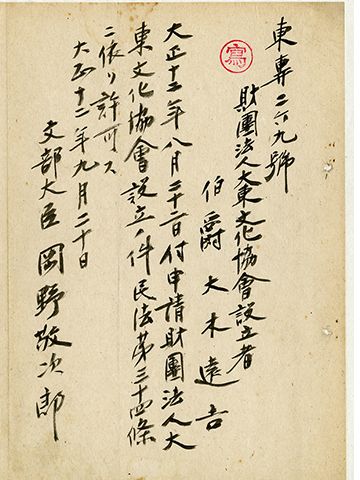
-
Enkichi Oki (1871 - 1926)
-
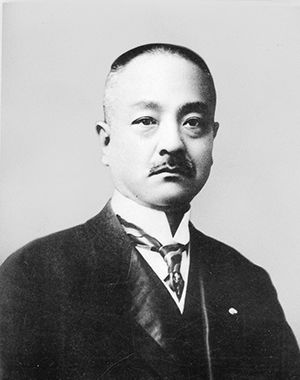
Oki served as the first president of the Daito Bunka Association.
Oki was a politician from the latter part of the Meiji period to the Taisho period. He successively held a variety of posts. He was a member of the House of Peers, minister of justice and minister of railways.
He was the heir of Takato Oki, the first minister of education. Oki jun. did not receive a formal education because he was sickly. His father and private tutors taught him at home, where an extensive collection of his father’s books surrounded him.
Oki succeeded to the title of count in November 1899 upon his father’s death that September. He was 28 years old at the time.
Oki entered politics in 1908 when he became a member of the House of Peers. There he formed a group called the Hakushaku Doshikai (the Society of Comradely Counts) in opposition to a group of ex-bureaucrats. He combined the Hakushaku Doshikai with the Kenkyukai, another faction in the House of Peers, in 1919.
From 1920, Oki served as minister of justice in the Hara and Takahashi cabinets. He joined the cabinet headed by Tomosaburo Kato as minister of railways in 1922. After retiring from government service due to the resignation of the entire cabinet (in August 1923), Oki was devoted to the combination of the Rikken Seiyukai, a political party, with the Seiyuhonto, another political party.
In addition to his role as president of the Daito Bunka Association, Oki served as a director at many private organizations, including the Teikoku Kodokai (Imperial Highway Association), the Dainihon Kokusuikai (Great Japan Patriotic Society), and the Teikoku Nokai (Imperial Farmers' Association). He was also known as an ultranationalist.
At the age of 56, Oki died of heart failure at an inn in Kyoto on his way back from Beppu, Kyushu, on February 14, 1926.

-
Heikichi Ogawa (1870 - 1942)
-
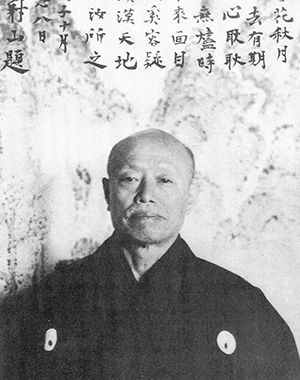
Ogawa was the first vice president and the fourth president of the Daito Bunka Association.
Ogawa was an active politician from the Meiji period to the first half of the Showa period. He served as an executive officer at the Rikken Seiyukai. As a cabinet member, Ogawa held various posts, including minister of justice and minister of railways. He assumed the pen name of Shasan.
Ogawa was the third son of eight children born to the kimono fabric dealer Kinzo Ogawa and his wife Aiko in Misayamagodo, Fujimi-mura, Suwa-gun, Nagano Prefecture. The Ogawas were a distinguished family in this area and owned considerable properties.
After graduating from the Buddhism course in the Faculty of Law at Tokyo Imperial University in 1892, Ogawa became a lawyer (then called "daigennin", renamed "bengoshi" in the following year with the enforcement of the Attorney Act). He organized the Nihon Bengoshi Kyokai (Japan Lawyers’ Association) in 1897. Ogawa aimed to reform the administration of justice. He assumed office as president of the Tokyo Bar Association in 1918.
Ogawa joined the Rikken Seiyukai simultaneously with its formation in 1900. He was elected to the House of Representatives for the first time in 1903, but started the Seiyukai reform movement and left. Ogawa rejoined the Rikken Seiyukai following Hirobumi Ito’s death in 1910. He became secretary-general of the Rikken Seiyukai in 1915.
Ogawa became president of the census institute under prime minister Takashi Hara in 1920. Ogawa resigned as a result of the resignation of the entire Takahashi cabinet in June 1922. Ogawa then served as minister of justice in the first Takaaki Kato cabinet (a cabinet formed by three factions in favor of the protection of the constitution) in 1925 and as minister of railways in the Giichi Tanaka cabinet in 1927.
At the same time, Ogawa was involved in the establishment of the Daito Bunka Association and Daito Bunka Gakuin. He served successively as vice president and president of the Daito Bunka Association.
Ogawa was imprisoned for involvement in a suspected bribery case in connection with the acquisition of five private railways during his term as minister of railways in 1929. He was found guilty in 1936 despite the temporary decision of not guilty. The ruling ended his political career. In connection with this development, Ogawa resigned as president of the Daito Bunka Association.
He was known as an ultranationalist. Ogawa began to show interest in continental affairs and issues involving East Asia around 1897 as well as the solution of ideological issues in Japan. After retiring from politics, Ogawa continued working actively in domestic and overseas affairs. In particular, he insisted on taking a hard line regarding issues in Manchuria and the Soviet Union and advocated for active continental policies. However, Ogawa asserted the need for direct peace talks with Chiang Kai-shek at the start of the Sino-Japanese War (1937-45). He was involved in peace movements by approaching military authorities and other actions. Those movements failed, but Ogawa maintained his strong opposition to a controlled economy, the Tripartite Pact (with Naz-Germany and Fascist Italy in 1940) and the start of a war against the United States from his position as an ultranationalist.
Ogawa died on February 5, 1942.
He was blessed with ten children. Many of Ogawa’s family members became famous in political and business circles. Former Prime Minister Kiichi Miyazawa was one of his grandchildren (a child of his second daughter Koto).

-
Kiichiro Hiranuma (1867 - 1952)
-
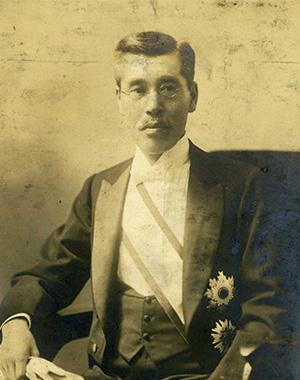
First president of Daito Bunka Gakuin and third president of the Daito Bunka Association.
Hiranuma was a judicial officer and a politician who was active from the Meiji period to the first half of the Showa period. He was the 35th prime minister. Hiranuma assumed the pen name of Kigai.
Hiranuma was the second son of Shin Hiranuma, a clansman of the Tsuyama domain, in Tsuyama, Mimasaka Province (now Tsuyama, Okayama Prefecture). Yoshiro Hiranuma, economic history scholar and Doctor of Law, who served as president of Waseda University, was his elder brother.
Hiranuma moved to Tokyo with his family in 1872. He studied Chinese classics, English and arithmetic from former Tsuyama domain clansmen Kosai Udagawa and Shuhei Mitsukuri (founder of Sansagakusha, a private school). Subsequently, Hiranuma enrolled in a preparatory course for the University of Tokyo in 1878, and entered the University’s Faculty of Law in 1883. Hiranuma graduated from the Imperial University at the top of his class in 1888.
Hiranuma became a probationary counselor at the ministry of justice in the same year. He worked in the civil affairs bureau. Then Hiranuma served as probationary judge at courts of justice in a variety of areas and judge at the Tokyo Court of Appeals. He was awarded the title of Doctor of Law in recognition of his service. Hiranuma was appointed as public prosecutor general in 1912. He took charge of cases, including the Siemens Scandal, the Home Minister Oura Case and the Yawata Steel Works Case, in the subsequent decade.
Hiranuma assumed office as minister of justice in the second Yamamoto cabinet in 1923. He was nominated as a member of the House of Peers in January 1924. However, he was appointed as privy councilor the following month. He assumed office as chairman of the Privy Council in 1936. Hiranuma also received the title of baron in 1925.
He formed a cabinet in January 1939 to assume duties from the Fumimaro Konoe cabinet. However, the entire cabinet resigned in eight months, mired in issues, such as rising international tensions due to the worsening of the global situation and the reconciliation of antagonistic forces domestically. Hiranuma assumed office as minister of home affairs in the second Konoe cabinet in December 1940. He remained in the third Konoe cabinet as minister of state.
Already much earlier, Hiranuma had established Mukyukai in 1915. He reorganized Kokuhonsha, a right-wing political organization, and became its president in 1926. He also agreed to lead Syuyodan. He aimed to promote the learning of Eastern ethics and the national spirit as an advocate of ultranationalism. In addition, Hiranuma assumed office as the second president of the Toyo Bunka Gakkai (Eastern Culture Society), created the Toyo Bunka Kenkyujo (Oriental Culture Research Institute), and became the founding director.
Hiranuma served as president of Nihon University from 1923 to 1932, the same period when he was the first president of Daito Bunka Gakuin.
He was generally considered to be a figure with far-reaching influences over bureaucrats and the Privy Council, mainly in legal circles. After Japan’s defeat in World War II, Hiranuma was prosecuted as a class-A war criminal in the International Military Tribunal for the Far East. He was sentenced to life imprisonment without work. Hiranuma was released on parole because of illness in 1952. He died on August 22 of that year.
Hiranuma assumed office as first president of Daito Bunka Gakuin simultaneously with its establishment in January 1924. He remained in that position until January 1925. In addition, Hiranuma was involved in deciding on Daito Bunka Gakuin’s school policies as a member of the pre-establishment committee for organizing the school platform and rules. He also took charge of the school subject compilation as chairman of the committee for establishing school subjects and courses of study.
At the first opening ceremony for the school held on January 11, 1924, Hiranuma stated the objective for Daito Bunka Gakuin’s establishment, saying that the school aimed to promote and spread Confucianism, which had assisted the 2,000 years of Imperial rule and refined the national polity and that school rules clarify this particular goal by establishing a course on Imperial studies. Positioning this as the ultimate goal, Hiranuma suggested that Daito Bunka Gakuin was the top educational institution for Chinese classics taught by prominent faculty members, saying that they were authorities in the respective schools of thought and great Confucian scholars of the day and that students would not regret devoting themselves to studies and taking the first step to delve into the mysteries of Confucianism.
Daito Bunka Gakuin’s faculty members included many prominent scholars in its early period. Tetsujiro Inoue, who would become second president of Daito Bunka Gakuin, took charge of philosophy. Other prominent early faculty members included Fusaaki Uzawa and Mannosuke Yamaoka in charge of law, and Yasukuni Matsudaira, Kenjiro Makino and Shuhei Uchida in charge of Chinese classics. Philosopher Reikichi Kita lectured on logic and psychology. Hiranuma’s brother, Yoshiro Hiranuma, also taught at Daito Bunka Gakuin as professor of economics since the school’s inauguration. The realization of such a faculty consisting of leading authorities in their respective fields with national and private university backgrounds is assumed to be significantly due to the many contacts of Hiranuma.
Hiranuma held office as president for just one year. However, voices respecting his educational policies remained for a long period afterward. He laid the foundation for education at Daito Bunka Gakuin.

-
Tetsujiro Inoue (1855 - 1944)
-
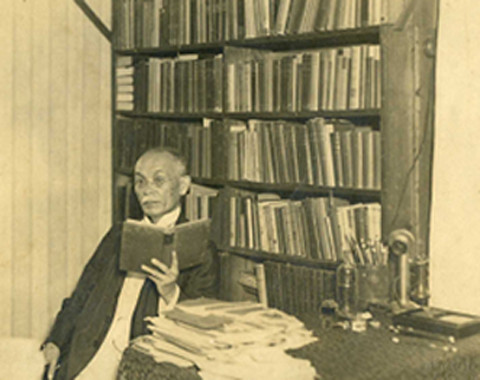
Inoue, who assumed the pen name of Sonken, was a philosopher active in the Meiji and Taisho periods. He was from Dazaifu, Chikuzen Province (now Fukuoka Prefecture). Inoue graduated from the Faculty of Philosophy at Tokyo Imperial University. The publication of Shintaishisho (A Selection of New Style Verse) with Masakazu Toyama and Ryokichi Yatabe brought Inoue fame in 1882. Inoue went to Germany for his studies in 1884. He pursued German idealism. Inoue returned to Japan in 1890 and took office as the first Japanese professor at the Tokyo Imperial University’s Faculty of Philosophy. Inoue retired from teaching in 1923.
In 1891, Inoue published Chokugoengi, an annotated edition of the Imperial Rescript on Education a year after the latter’s issuance and supplied the Imperial Rescript with a philosophical background. Inoue also wrote a serialized article titled Kyoiku to Shukyo no Shototsu (Conflict between Education and Religion) in a magazine. It denounced Christianity as a religion against the national polity and evoked a massive response. In the subsequent period, Inoue consistently discussed the existence of national morality under the emperor system.
In February 1925, Inoue assumed office as the second president of Daito Bunka Gakuin. He remained in this position until October 1926. Inoue also contributed articles to several issues of Daito Bunka Magazine, including the inaugural one (published in March 1924). Criticism emerged against the lack of respect in his interpretation of the three sacred treasures (sword, mirror, jewel) of imperial rule in his book Waga Kokutai to Kokumin Dotoku (Our National Polity and National Morality) in 1926. Inoue resigned from all public offices, including those at Daito Bunka Gakuin, to avoid escalation of the issue.
Major books by Inoue include Sonken Ronbunshu (Collection of Essays by Sonken [= Tetsujiro Inoue] ), Nihon Yomeigakuha no Tetsugaku (Philosophy of the Wang Yangming School in Japan), Nihon Kogakuha no Tetsugaku (Philosophy of the Kogaku School of Confucianism in Japan), Nihon Shushigakuha no Tetsugaku (Philosophy of the Zhu Xi School in Japan) and Kokumin Dotoku Gairon (Introduction to National Morality). He died at the age of 88.

-
Teachers in the Early Days
-
Tetsuji Morohashi (1883 - 1982
Professor
Daito Bunka Gakuin
Professor Emeritus
Tokyo Bunrika University
First President of Tsuru UniversityMorohashi assumed the pen name of Shiken. Morohashi was born in Morimachimura, Nankan-gun, Niigata Prefecture (now Shimoda, Sanjo City). He went to China in 1919 to study for two years after graduating from Tokyo Koto Shihan Gakko (which later became Tokyo Bunrika University, then Tokyo University of Education, which is the predecessor of today's University of Tsukuba). After returning to Japan, Morohashi assumed the post of professor at Daito Bunka Gakuin simultaneously with its establishment in 1923.
In the same period, Morohashi worked on compiling Dai Kan-Wa Jiten (The Great Chinese-Japanese Dictionary) for Taishukan Publishing Co., Ltd. According to one theory, he accepted work on this project partly based on his view that it was perfect for helping students at Daito Bunka Gakuin with their living expenses.
Morohashi retired from service at Daito Bunka Gakuin in 1929 to participate in the establishment and formation of the Chinese classics course at Tokyo Bunrika University, his alma mater. Morohashi engaged in education at Kokugakuin University and Tsuru University after many years of service as a professor at Tokyo Bunrika University.
In the course of his long life, Morohashi carried out a lot of research, including supervision over the already mentioned 15-volume Dai Kan-Wa Jiten.
The house where he was born remains as it was. The Tetsuji Morohashi Memorial Hall was built adjacent to it.
Shigeta Oyanagi (1870 - 1940)
Oyanagi was born in Kamihonaimura, Niigata Prefecture (now Kaminohai, Sanjo). Oyanagi entered the Tokyo Imperial University in September 1891 and pursued Chinese classics after studying at Chozenkan, a private school in Yoshida-machi, Nishi Kanbara-gun. After graduating, Oyanagi taught Chinese classics at many institutions of higher education, including Tetsugakukan (now Toyo University), Gakushuin University, Tokyo Imperial University, Kokugakuin University, and Keio University.
Oyanagi became a professor at Daito Bunka Gakuin in April 1926. Subsequently, he put all his effort into the development of Daito Bunka Gakuin and education. Oyanagi became the principal (kyo-to) of Daito Bunka Gakuin in 1938 and became the only person called "president" during the period when the school name was Daito Bunka Gakuin, because the former title of "kyo-to" was changed to "gaku-cho" (president) for the period between April and December 1940.
As a Doctor of Literature, Oyanagi was the leading authority on the Chinese classics and Taoism. Oyanagi is mainly known as supervising editor of Shinshu Kan-Wa Dai Jiten (Revised Chinese-Japanese Dictionary). Still he also left behind many other books, including Roso no Shiso to Dokyo (The Philosophy of Lao Zi and Zhuang Zi, and Taoism) and Toyo Shiso no Kenkyu (Studies of Oriental Thinking), based on his energetic studies.
Mizuho Kawada (1879 - 1951)
Assistant professor
Daito Bunka Gakuin
Professor
Waseda UniversityKawada was born in Kochi Prefecture. He took his pen name, Setsuzan, from Sekkozan, a mountain in his home region of Tosa (Kochi Prefecture). Kawada was a scholar of Chinese classics, active from the Meiji period to the first half of the Showa period.
Kawada entered the Department of Politics and Economics at Tokyo Senmon Gakko (now Waseda University) after studying Chinese classics from Baigai Yamamoto, his senior from Tosa, at Baiseishojuku, a private school Yamamoto had opened in Osaka. Kawada worked hard to establish the Daito Bunka Association and Daito Bunka Gakuin in 1923. He took charge of Nihon Seiki, a history book, and other studies as an assistant professor. Kawada moved to the higher normal school affiliated with Waseda University (which later became the university’s Faculty of Education) as a professor in 1930. There he taught Chinese classics until 1950.
Kawada also played a central role in the early years of Mukyukai, which was established by Kiichiro Hiranuma, first president of Daito Bunka Gakuin. There he served as acting president and director. He was also devoted to the study and dissemination of Chinese classics throughout his lifetime as one of Toyo Bunka Gakkai’s founders.
At the end of the Pacific War, Kawada drafted the Imperial Rescript on Surrender as a temporary employee of the secretariat for the Kantaro Suzuki cabinet. This Imperial Rescript came into effect after being edited by Chief Cabinet Secretary Hisatsune Sakomizu, and Ministry of Greater East Asia advisor Masahiro Yasuoka, a neo-confucianist of the Wang Yangming School.
As a reference, the following well-known opening phrase in the Imperial Rescript remained the same as in the original draft by Setsuzan Kawada. “To our good and loyal subjects: after pondering deeply the general trends of the world and the actual conditions obtaining in Our Empire today, we have decided to effect a settlement of the present situation by resorting to an extraordinary measure.”
In addition to Kawada, Sakomizu and Yasuoka, many prominent figures in academic society participated in the production of the Imperial Rescript.
Major scholars of Chinese classics involved in Daito Bunka Gakuin from its establishment to the early days include Confucian scripture scholar Kotaro Yasui (Bokudo Yasui), the author of Nihon Jugakushi (History of Confucianism in Japan); Shirojiro Ikeda, a known expert on Japanese history; Neoconfucianist Tetsuji Morohashi (Shiken Morohashi), the supervising editor of Dai Kan-Wa Jiten, the largest Chinese-Japanese dictionary in the world consisting of 15 volumes; Mizuho Kawada (Setsuzan Kawada), who drafted the Imperial Rescript on Surrender at the point of Japan’s defeat in 1945; Chinese-style poet Hisayasu Tsuchiya (Chiku-u Tsuchiya), referred to as the last great poet in that style; Confucian scripture scholar Kenjiro Makino (Moshu Makino), an active leader at the so-called Waseda school, who led the Chinese classics promotion movement that was partially responsible for the establishment of Daito Bunka Gakuin; Oriental thought scholar Shigeta Oyanagi; Oriental historian Kyushiro Nakayama; Historian and oriental astronomer Tadao Iijima; Neo-confucianist Shuhei Uchida; Chinese-style poet Takatsugu Kokubu (Seigai Kokubu); Chinese character Scholar Kotaro Kawai; Confucianscripture scholar Shinji Takada (Token Takada); Chinese character scholar Joken Kato (Iken Kato); Wang Yangming School adherent Jun Yamada (Seisai Yamada); and Confucian scripture scholar Chikashi Fujitsuka. Daito Bunka Gakuin boasted a long list of prominent scholars during its early years.
Besides, many Chinese classics scholars were active during and after World War II, who had graduated from Daito Bunka Gakuin Senior High School. People such as Moku Kondo, Akira Shimotomai, Taneshige Harada, Teruo Kasai (Nanson Kasai), and Atsushi Inokuchi became teachers devoted to education at Daito Bunka Gakuin after leaving high school.
-
- 1932
The tenth anniversary of the founding
Daito Bunka Gakuin, the forerunner to the University, engaged in various undertakings to commemorate the 10th anniversary of its founding in October 1932.
They included the following.
- Commemorative ceremony (celebration)
- Commemorative lectures (Lectures by four professors)
- Establishment and announcement of the school banner and the school song
- Publication of Soritsu Jusshunen Kinen Daito Bunka Kyokai Daito Bunka Gakuin Soritsu Enkaku (A Short History Commemorating the 10th Anniversary of the Founding of Daito Bunka Kyokai and Daito Bunka Gakuin), edited and issued by the Daito Bunka Association and Daito Bunka Gakuin on October 13, 1932
- Publication of Soritsu Jusshunen Kinengo (Commemorative Issue for the 10th Anniversary of the Founding) edited and issued by Daito Bunka Association and Daito Bunka Gakuin on December 25, 1932
Soritsu Jusshunen Kinengo records details of the commemorative ceremony (celebration). The publication also contains a list of guests invited to the ceremony. Prominent figures, including Prime Minister Makoto Saito, Imperial Household Minister Kitokuro Ichiki, Home Minister Tatsuo Yamamoto, and Education Minister Ichiro Hatoyama, delivered congratulatory addresses. In addition, the school banner designed by a student at the seventh anniversary of the founding and the school song by Seigai Kokubu were formally established at the commemorative ceremony for the 10th anniversary of the founding.
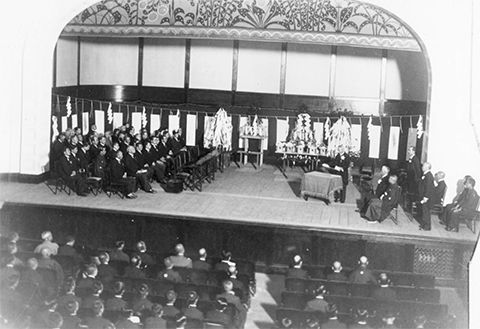
A commemorative rally for the 10th anniversary of the founding was held at the Nippon Seinen-Kan Hall in the Outer Gardens of the Meiji Shrine. -
- 1943
The twentieth anniversary of the founding
Daito Bunka Gakuin celebrated the 20th anniversary of its founding on September 20, 1943.
Whether a commemorative ceremony for the 20th anniversary was held during the war is unknown. However, remaining records state that a commemorative booklet was published as part of a project for commemorating the school anniversary.
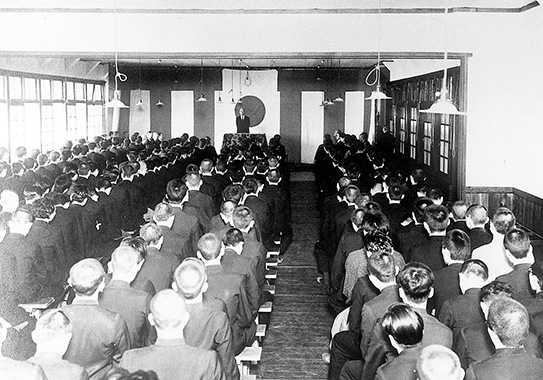
Ikebukuro campus opening ceremony in 1941 -
- 1949
The establishment of Tokyo Bunsei University, organized under the new post-war educational system, was approved.
In April 1949, Daito Bunka Gakuin Senmon Gakko was promoted to a university organized under the new educational system. The school changed its name to Tokyo Bunsei University as the Ministry of Education, Science, and Culture rejected the continued use of "Daito Bunka," based on the view that the name was undesirable and reminiscent of the wartime concept of "Daitoa" = "Greater East Asia." Tokyo Bunsei University was launched as a college with only the Faculty of Literature and Politics. As the Ikebukuro Campus had been destroyed in the wartime fires, the reconstruction of the school grounds and library facilities were in progress during the early post-war years.
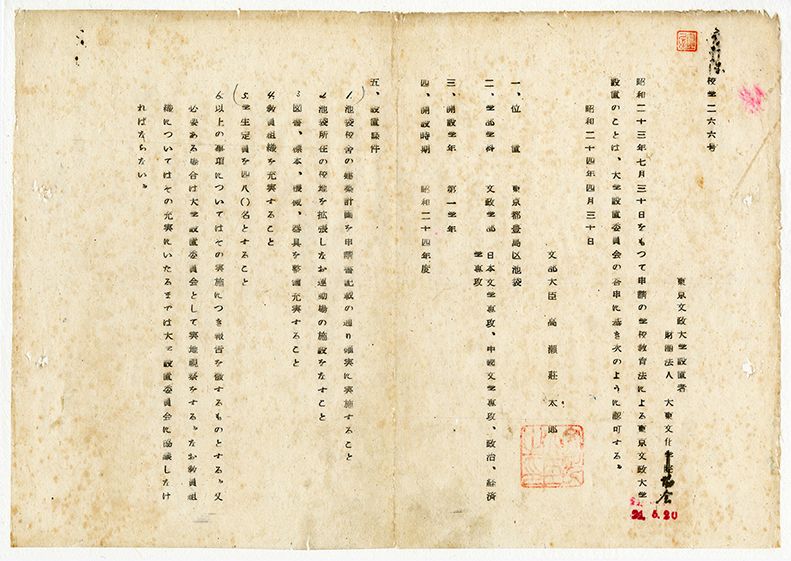
-
Hisayasu (Chiku-u) Tsuchiya (10 April 1887 - 5 November 1958)
-
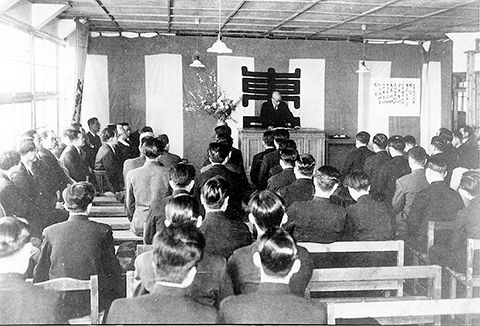
Tsuchiya was the first president of Tokyo Bunsei University, which was organized under the new post-war educational system. (Tokyo Bunsei University changed its name to Daito Bunka University four years later.) He laid a foundation for Daito Bunka’s reconstruction and development during that period.
Tsuchiya came from Tsuruoka, Yamagata Prefecture. He was the first son of Shonai domain clansman Hisakuni Tsuchiya and his wife Suma. His real name was Hisayasu, but he used the alias of Shiken and the pen name of Chiku-u. Tsuchiya reportedly assumed the name of Chiku-u (meaning bamboo and rain) after viewing marbled bamboo from a window of his study.
He entered Tokyo Imperial University’s Faculty of Law after graduating from Shonai Junior High School (now Tsuruoka Minami High School) and Dai-ni Senior High School in Sendai. After his graduation from the University in 1914, Tsuchiya studied under Inken Osuga and others and pursued Chinese-style poetry.
Tsuchiya became a manager at the Daito Bunka Association in 1923. He participated in the launch of the Daito Bunka Magazine and served as its editor-in-chief for many years. Tsuchiya became a lecturer at Daito Bunka Gakuin in 1931 and a professor in 1935.
He moved to Tsuruoka, his hometown, and taught Chinese-style poetry there during the war. He returned to Daito Bunka Gakuen after Japan’s defeat. Tsuchiya assumed office as the first president of Tokyo Bunsei University, which was organized under the new post-war educational system, in 1948. At the same time, he became the 14th president of Daito Bunka Gakuin Senmon Gakko. He led the school during its transition from a vocational school into a new-system university. Tsuchiya maintained his position as president until just before his death in 1958.
Chiku-u Tsuchiya is widely known as the leading authority on Chinese-style poetry in the Showa period. Tsuchiya was referred to as the last Chinese-style poet and a prominent figure in that world. Tsuchiya idolized and studied under prominent Chinese-style poet Seigai Kokubu (professor at Daito Bunka Gakuin and lyricist of its school song) as a student at the Imperial University Tokyo. He taught at Daito Bunka Gakuin along with Kokubu and subsequently contributed to Chinese-style poetry education in Japan. Tsuchiya started a magazine called “Toka” at Geibunsha, a defunct publisher, in 1928. He joined the Japan Art Academy in 1949. One year later, he assumed office as advisor to Ibunkai (now Chido Museum) in Tsuruoka.
Tsuchiya was not very keen on writing research papers. He had a pure love for the world of Chinese-style poetry. Tsuchiya actively produced Chinese-style poetry anthologies and engaged in instruction at many poets’ societies, including Yokoginsha. Major works by Tsuchiya include Nihon Hyakunin Isshi (Sunagoya Shobo, 1943) and Kiryoshiko Ken Kon (Geibunsha, 1957). The latter is a self-selected collection of his Chinese-style poems.
Tsuchiya was buried at his family’s gravesite at Tama Cemetery in Tsuruoka. He died at the age of 71.

-
- 1953
Application for changing the school name to Daito Bunka University
Tokyo Bunsei University dropped "Tokyo" from its school name after two years. However, concerned people, including many alumni had a deep emotional attachment to the name Daito Bunka. Leaders at Bunsei University decided to apply for a name change partly in response to repeated requests. Bunsei University was permitted to change its name to Daito Bunka University in April 1953, on the 30th anniversary of its founding, four years after its status change to a university organized under the new educational system. Diplomas were presented to the first graduating class under the name Daito Bunka University. Therefore, the name Tokyo Bunsei University soon faded from history.
A new school song was established and announced to replace the old one at the commemorative ceremony for the 30th anniversary of the founding due to various reasons, including the name change. Kanae Tani, who taught at Daito Bunka University at that time, wrote the lyrics of the new song, which was accepted by the faculty council with some minor corrections of the text.
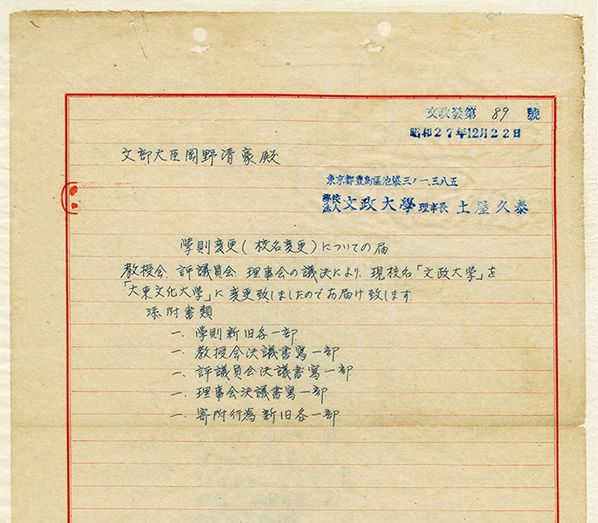
-
The thirtieth anniversary of the founding
The school was promoted to a new-system university on September 20, 1953, despite the many problems it experienced after Japan’s defeat. However, it was forced to change its name from Daito Bunka to Tokyo Bunsei University. In the year of the 30th anniversary of the founding, the school was permitted to return to the name Daito Bunka, as it had long desired, and enacted the change.
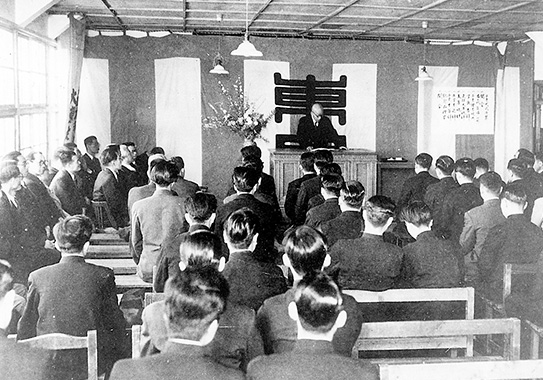
First graduation ceremony for Daito Bunka University in 1953 -
- 1963
The fortieth anniversary of the founding
In April 1960, three and a half years ahead of the 40th anniversary of the founding (September 20, 1963), the Board of Trustees created a multifaceted management policy based on the idea of diversification and further expanding the school.
Titled the “Promotion Plan Commemorating the 40th Anniversary of the Founding,” this policy proposed acquiring a spacious school ground in Itabashi-ku and moving the university from its old Ikebukuro Campus there, expanding from one faculty to two faculties with four departments, and establishing a senior high school and a technical school (light electrical appliances and civil engineering courses) as schools affiliated with the university on the occasion of its 40th anniversary. Furthermore, the policy set out a future plan to equip the university with six departments in three faculties, including the Faculty of Engineering, aimed at accepting graduates of technical schools, transforming Daito Bunka into a comprehensive university with both humanities and science branches and simultaneously evolving Daito Bunka Gakuen into a school organization with graduate schools and kindergartens.
Based on this Promotion Plan, the University moved its programs from the Ikebukuro campus to the Itabashi campus in 1961. The Faculty of Literature and Politics was reorganized to establish the Faculty of Literature and the Faculty of Economics in the 1962 academic year. Daito Bunka University Dai-ichi High School opened simultaneously in the 1962 academic year. Daito Medical Technology and Seifuku Vocational School joined as an affiliated school in 1961.
The commemorative ceremony for the 40th anniversary of the founding was held on a grand scale during this period, when the University was progressing with expanded faculties, departments and affiliated schools.
A votive panel with a Chinese-style poem written by Daito Bunka University professor Shinji Takada to commemorate the 40th anniversary remains at the Daito Archive.
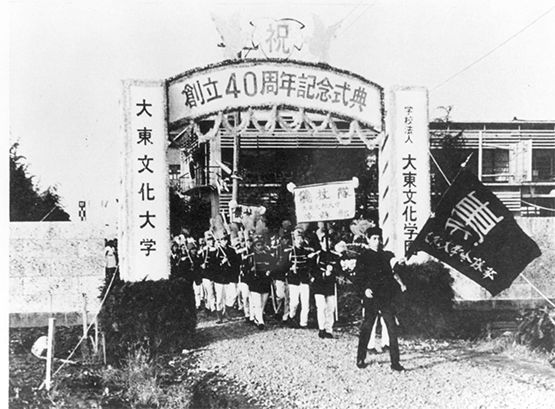
Procession march at the 40th anniversary commemorative ceremony -
- 1973
The fiftieth anniversary of the founding
In connection with the fiftieth anniversary of the foundation of the school (celebrated on September 20, 1973), Daito Bunka University first set up the Faculty of Foreign Languages in the academic year 1972, followed by the Faculty of Law one year later. Daito Bunka University expanded its school system to consist of four faculties with nine departments, including a postgraduate advanced course, and two graduate schools. Its school system grew to encompass Daito Bunka University Dai-ichi High School, Eishin Senior High School, Eishin Junior High School, Eishin Elementary School, Eishin Kindergarten, Aogiri Kindergarten, and Daito Medical Technology Vocational School as affiliated schools.
Already five years earlier, the university had added the new, very spacious Higashi Matsuyama Campus to the older Itabashi Campus. The Faculty of Liberal Arts had begun to offer classes on the Higashi Matsuyama Campus in the 1967 academic year.
Grand commemorative projects were undertaken to celebrate the passage of a half century after the school’s founding.
In addition to opening new faculties, the university complied and published the 50-Year History of Daito Bunka University, the first full-scale school history that continues to occupy a central position as the university’s official chronicle. The issuance of various anniversary publications seems to have become a popular custom during this period. Furthermore, the university advanced the redevelopment of the Itabashi Campus with the 50th anniversary of the founding. The university built the six-story 50th Anniversary Memorial Hall, whose inauguration ceremony was held on the same day as the commemorative ceremony for the 50th anniversary of the founding.
During this period, Nobusuke Kishi was the chairman of the Daito Bunka University Supporters’ Association, while Takeo Fukuda was its deputy chairman. Many guests from political circles attended the grand commemorative ceremony.
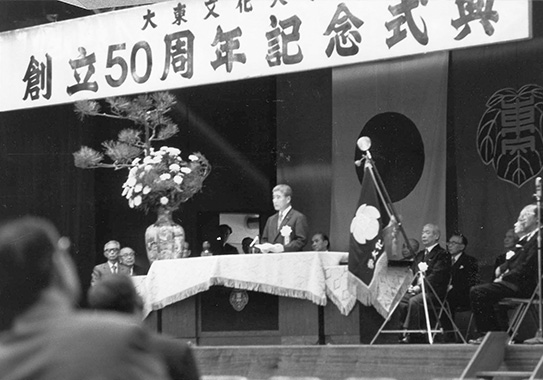
Commemorative ceremony held at the newly constructed 50th Anniversary Memorial Hall -
- 1983
The sixtieth anniversary of the founding
The University did not establish any faculty for 10 years after setting up the Faculty of Law with the 50th anniversary of the founding on September 20, 1973. Instead, the University upgraded the educational environment during this period.
The university improved the teacher-student ratio from 1:50 at the worst point, to 1:30 by this period. It simultaneously worked to enhance the environment for education and research by constructing the Research Management Building (now No. 2 Building) on Itabashi Campus in 1980. In addition, the university opened Tsumagoi Seminar House (1975) and Daito Bunka Hall (1976) during this period. It was also during these years that the university began supporting research activities from an international perspective. It introduced a system for dispatching full-time faculty members overseas for medium- and long-term research and training in the 1976 academic year.
The university created a plan to expand the Higashi Matsuyama Campus in 1983, when it celebrated the 60th anniversary of its founding. It spent the next ten years, until the 70th anniversary of its founding, on redeveloping the Higashi Matsuyama Campus.
The grand commemorative ceremony for the 60th anniversary of the founding was held at the Hotel Century Hyatt. Publications issued to commemorate the 60th anniversary of the founding included Traces (Kiseki), Daito Bunka University Calligraphy Exhibition, and Collection of Sinology Papers - all with "Commemorating the 60th Anniversary of Daito Bunka University" as part of their title. Furthermore, the Institute for Oriental Studies reissued the magazine Ex Oriente.
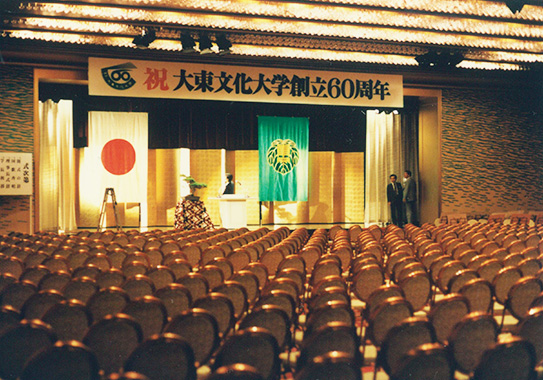
The commemorative ceremony for the 60th anniversary of the founding was held at the Hotel Century Hyatt. -
- 1993
The seventieth anniversary of the founding
Many publications were issued to commemorate the 70th anniversary of the founding on September 20, 1993.
They included the 70-Year History of Daito Bunka University, the Collection of Research Papers Commemorating the 70th Anniversary of Daito Bunka University (three volumes), the 32nd Issue of the Daito Bunka University Chinese Classics Study Journal Containing Research Papers Commemorating the 70th Anniversary of the Founding, and Ethnic Groups and Nations in the 21st Century, an 11-volume report on an academic investigation and research project commemorating the 70th anniversary of the school.
Meanwhile, the Board of Trustees made a final decision against holding a commemorative ceremony and various commemorative events this year. Only publications and mementos were distributed as a result.
Ahead of the 70th anniversary, the university opened the Faculty of International Relations in the 1986 academic year. Its establishment gave the university 13 departments in five faculties. The Daito Bunka University evolved into a large humanities university boasting many students. In this period, one university after another temporarily expanded its admission quotas to deal with the Baby Boomer generation and an increase in the percentage of students enrolling. The university expanded admission quotas temporarily in stages from the 1986 academic year to the 1991 academic year to the 1992 academic year, too. The number of enrolling students increased year after year. To cope with the rapid increase in the number of students, the university spent about ten years expanding the Higashi Matsuyama campus, whose redevelopment had been announced on the 60th anniversary, set up a school bus service, and equipped the campus with facilities including an indoor swimming pool and a playground. In 1989, the university completed Building No. 1 on Itabashi Campus.
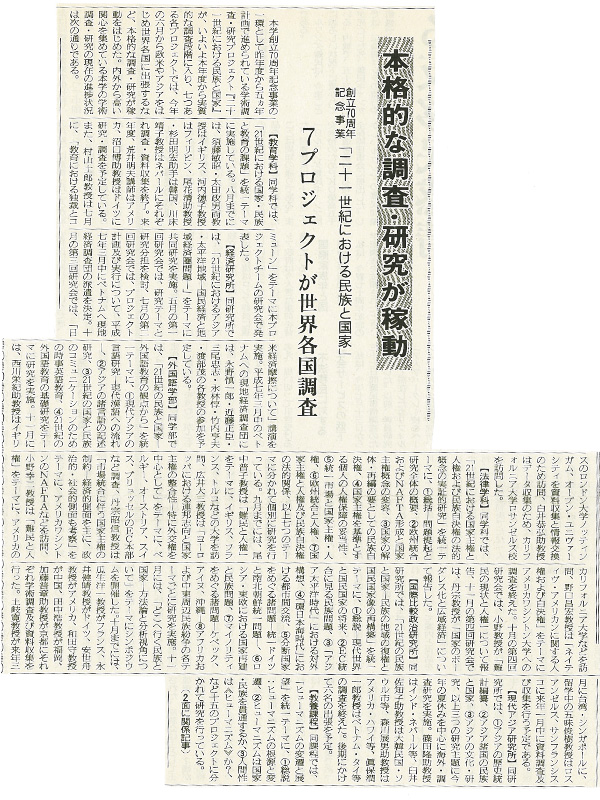
School newspaper report on the Ethnic Groups and Nations in the 21st Century research project undertaken to commemorate the 70th anniversary of the founding -
- 2003
The eightieth anniversary of the founding
The grand commemorative ceremony for the 80th anniversary of the founding was held at Hotel Metropolitan on September 20, 2003.
Students also voluntarily hosted the Gathering Where a School 80 Years Old Meets People 80 Years Old (the 80-80 Gathering), an event marking the 80th anniversary of the founding of the University, where participants heard stories from 80-year-olds from the University’s neighborhood. Through this project, graduate and undergraduate students at Daito Bunka University visited mainly elderly groups in the local community from October 2003 to February 2004, and listened earnestly to the experiences and opinions of elderly participants. A total of 187 elderly people cooperated with the students.
Publications were issued to commemorate the 80th anniversary of the founding, such as Set the Hearts Free in This World and Keep Eyes on World Changes (a journal commemorating the 80th anniversary) and the Commemorative Journal for the 80-80 / Hello-Hello Gathering. A 80-Year-Old school meets 80-Year-Old People, a Project for Commemorating the 80th Anniversary of the Founding of the Daito Bunka University.
Ahead of this anniversary, the Faculty of Business Administration and the Faculty of Social-Human Environmentology opened in 2000 and 2001. With their addition, the university became a large school with more than 14,000 undergraduate and graduate students in 17 departments in seven faculties. The Department of Calligraphy also opened during this period. The current library and Building No. 3 were constructed as a result of this redevelopment drive at Itabashi Campus. A certain consciousness of the beginning of a new era has become prominent. An example for this was the decision for a university mascot called "Parabun" in 2001.
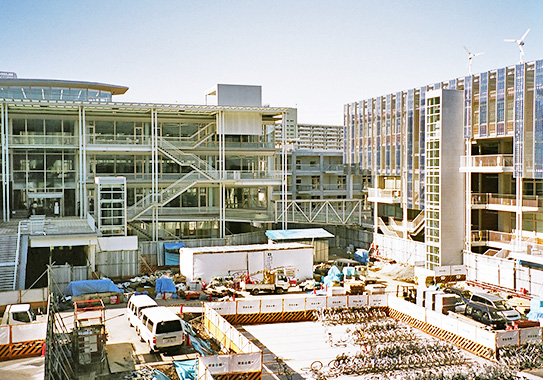
Redevelopment of the Itabashi Campus executed as a commemorative project for the 80th anniversary of the founding -
- 2013
The ninetieth anniversary of the founding
A commemorative ceremony was held on September 20, 2013. Other commemorative events, such as an academic symposium, homecoming and the WALK event, took place on the anniversary. A commemorative logo and sticker were produced. In addition, school facilities were decorated to commemorate the 90th anniversary of the founding, and many commemorative goods were sold. The University implemented these new initiatives for the occasion. The Course Taken by Daito Bunka University, a booklet commemorating the 90th anniversary of the founding, was published as a commemorative project.
The university opened the Daito Bunka University Beatrix Potter Reference Library and the Daito Archives in the decade following the 80th anniversary. Subsequently, archival activities began across the university, and the university has used the Peter Rabbit character since then. Furthermore, the university opened the Law School at the Shinanomachi Campus in 2004, set up the Faculty of Sports & Health Science in 2005, and closed Daito Medical Technology Vocational School in 2012. The university advanced internal consolidation, including the restructuring of its departments.
The university redeveloped the Itabashi campus on a large scale from 2003 to 2006 and set up new facilities, including the library and Building No. 3. Currently, the redevelopment of the Higashi Matsuyama campus is underway. Through the project for redeveloping the Higashi Matsuyama campus that began in October 2010, pedestrian bridges connecting New Building No. 3 with Building No. 10 and New Building No. 4 with New Building No. 5 (dubbed Furatto Street) were established anew. The three-story New Building No. 2 (5,100 square meters in gross area) was in the third stage of construction, the culmination of the campus preparation project.
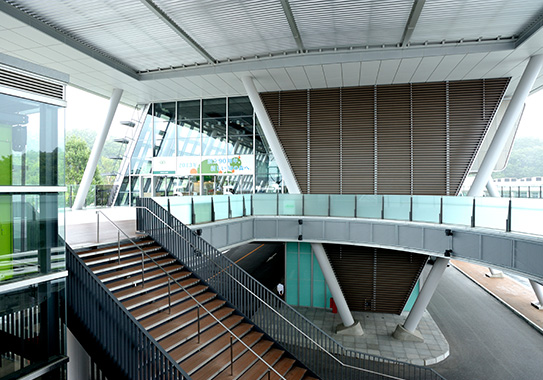
The Higashi Matsuyama campus was redeveloped through a project commemorating the 90th anniversary of the founding. -
- 2023
One hundredth anniversary of the founding



